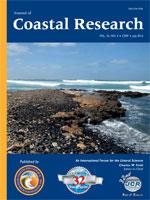This is a neat little book by Eric Bird and Nick Lewis, both of whom are experienced coastal researchers. Although the volume is only 135 pages long as part of Springer Briefs in Earth Sciences series, the authors manage to hit most of the highlights and critical issues surrounding beach renourishment. Having said that, it means that no particular topic gets exhaustive treatment, as that is not the point of Springer Briefs. The coverage is, however, sufficient to give the reader a first glimpse of the issues and practices associated with this predominantly shore protection technique that is sometimes referred to as “soft stabilization or engineering.” This term is applied in opposition to hard stabilization, which deploys engineering structures such as seawalls, groins, revetments, breakwaters, etc. instead of sand. The sand that is applied to eroding shores is regarded as sacrificial in the sense that it needs to be replaced, as it becomes “lost” to the offshore or downdrift coastal segments.
The book starts out by discussing the most commonly encountered cause of beach erosion, which is loss of sediment from the beach to such a degree that the dry beach width is reduced. The process is commonly referred to as shoreline retreat, as this is what most people observe or experience, notwithstanding the fact that beach sand can move offshore to the submerged part of the beach. This is the right place to start the book, as sediment supply is the crux of the matter. The principles of beach renourishment are next briefly discussed to advantage, emphasizing the importance of preliminary investigations, sand searches (sources of sediment for renourishment), methods of emplacement along the shore, and design considerations confronting coastal engineers.
Not to be forgotten is the process of monitoring changes over time after placement of the sand on the shore. This is a critical phase of the process because this is where lessons are learned. That is to say, this phase of renourishment projects attempts to ascertain why projects perform well or poorly. Assessment of project performance is critical to increased understanding of why some projects fail or do not perform as well as intended (as determined from the design life of the beach), and lessons are learned from such analyses to avoid the same pitfalls in future projects. It is a learning experience, and the authors bring out many ancillary aspects of the process that are related to potential environmental impacts of dredging alongshore on the seabed, loading and transport of the sand from offshore to the beach, and impacts associated with emplacement of sand on the shore.
Every beach renourishment project is unique because coastal segments differ from one another and require careful study before, during, and after completion. And many countries approach the process in slightly different ways to match their resources (biophysical and socioeconomic) and needs. Hence, there is discussion of different approaches to beach renourishment in various geographic regions.
In the opinion of the reviewer, who has hands-on experience working on many beach renourishment projects, the authors have done a laudable job of summarizing key points and issues. This book thus may well serve as a primer for those not initiated into the beach renourishment experience. This paperback is handsomely produced, and diagrams and color illustrations support the text. As a quick introduction to a complex process, this book provides effective oversight and relevant perspectives that are not biased pro or con for a process that is not without controversy.
I recommend the book to those researchers and workers who are just starting out in the field and who wish to get an overview of the subject. And for those of us who are or have been involved with aspects of beach renourishment, this handy book will serve as refresher. In many ways, this book is like an apophoreta and is indeed something to be savored before the main course of investigation into the ins and outs of beach renourishment. For coastal managers, this book would seem to be a “must have” because it succinctly presents most aspects of beach renourishment in understandable terms without invoking technical jargon that is so familiar to practitioners. I recommend Beach Renourishment unreservedly to consultants, politicians, managers, students, and members of the academy in professorial ranks.






